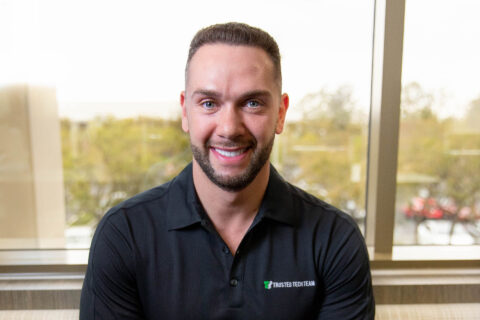In 2015, I was one of three engineering managers up for a promotion to director. Over the previous two years, I had worked hard to show myself capable. I had made personal changes that turned me into a better manager. My people were happy. My projects were succeeding. I was meeting deadlines.
Still, I felt like the VP held the power to dictate the next step in my career; if he allowed me to move up, great, otherwise it seemed like I would be stuck in a dead-end job without options. I told a friend about the promotion and my concerns, and in response, she said, “You have what it takes to be a senior manager, if not in this place, then somewhere else.”
It was like a light bulb suddenly went on. My friend was right. If I didn’t get the promotion here, I would find another way to move up to a director position. I didn’t need to wait for this VP to think highly of me and make a decision. I could look outside my company now if I wanted to.
“I held the power to choose my next step.”
As I considered my friend’s words over the following weeks, I realized that my career was not in the VP’s hands. It was in mine. I wanted that promotion, and I was going to get it, whether at this company or somewhere else. I held the power to choose my next step.
Taking control of the future
Getting to this place mentally and in my career didn’t happen overnight. For many years, I simply worked as a software engineer. I gave no thought to where my career was heading, and even though I always had a strong work ethic and was a talented developer, I never expressed interest in moving up to manager. The longer I stayed in the same position, however, the more men I saw advance to team lead. Finally, I decided I wanted to prove that I was capable of doing the same. I talked to my manager, who promised that when a position opened up, it was mine.
But that’s not what happened. He gave the team lead role to someone else.
I was so disappointed. I couldn’t understand his decision. I asked to be transferred to a different group and immediately told my new manager that I wanted to be team lead. He hesitated a little and then said, “You are perceived as very aggressive. People are intimidated by you. That’s not a good fit for a team lead.”
Though his feedback was gendered—a man would be much less likely to hear the same message—it was also true. I was more aggressive than any man I met at work back then. Sharing that information was one of the nicest things anyone has done for me in my career, even though it was hard to hear at the time.
It took a while, but I finally showed my manager that I could change. He promoted me to team lead, and within a few years, I was managing a project that included thirty people in four countries.
From management to motherhood
During this time, I got married and my husband and I decided we wanted to have children. This launched us on a complicated and painful journey of fertility treatments, miscarriages, and surrogacy that, thankfully, culminated in the birth of our three children.
Those were dark years. The fertility treatments broke my spirits and greatly affected my hormones, which in turn affected my energy level and mental state. Because of the emotional difficulties, I struggled to hold a managerial position. After giving birth to my first child, I left high tech and became a personal coach. Interestingly, as I helped others, I grew myself. I spent a great deal of time on personal development: going to therapy, understanding myself better, and working on my blind spots and confidence. Working through these issues was hugely important to me and my growth.
After a year, I realized that I belonged in high tech—and, more specifically, in software engineering. Being far away from coding made me realize how much I missed it. As a result of the personal work I had done, I became less argumentative and insensitive. I learned to put relationships before results, which improved results because my team’s commitment to me and the company grew in response to the way I treated them.
“I also took time to observe the people around me who had advanced to senior executive roles and recognized the reasons for their success.”
I also took time to observe the people around me who had advanced to senior executive roles and recognized the reasons for their success:
- They don’t let failure dictate who they are. They shake it off and move on.
- They take every opportunity to advance.
- They don’t wait for someone else to tell them they are ready to advance.
- They don’t hesitate when offered a position that is more challenging than what they’ve done before. They believe they can do it.
Forward movement
Around the same time that I made these observations, I had the revelation mentioned earlier, that my career was in my hands, not the VP’s. Shortly after I got promoted. After a while, I took a director position at another organization. When that company closed, I set my sights even higher—I wanted to become vice president, a position I wouldn’t have dreamed of pursuing a few years earlier because that option didn’t even occur to me. By early 2017, I had achieved this goal. I had gone from software engineer to VP of R&D in less than two years.
This path of advancement on steroids was only possible because I changed my mindset. I started taking more chances, and my fear of failure and not being up for the task disappeared.
A message to women
Perhaps you can relate to the early years of my career. Maybe you’ve been working at the same company, maybe even in the same position, for years, and until recently you’ve never really thought about what’s next. Maybe you’ve been trying to advance, but so far you haven’t succeeded. Maybe you doubt your ability to handle the work at the next level. Maybe you’ve faced discrimination or resistance. Maybe you’re feeling alone.
I’ve been there.
I know how it feels to be the only female in the room, to not have a female role model. I’ve managed to climb the ladder despite these things.
If you want to “woman up” and climb the high-tech ladder, especially if you want to do it quickly, you need to take chances. You need to work on those inner challenges that are holding you back, whether it’s a lack of confidence or imposter syndrome. You need to be brave.
This world is broken in so many ways. Women and other minorities still experience discrimination in high tech, and as a result, many aspects of our careers are still outside of our control. Still, we can each show up as our best selves and take steps to fix this reality so women in the future do not have to live with it.
Anat Rapoport has worked her way through every rank in the engineering and technology industries. She has been VP of engineering at multiple companies and was GM and co-CEO in her last two roles. Rapoport is an experienced R&D manager with a Master of Science in computer science from Tel Aviv University. She is an Israel Defense Forces 8200, and a mom of three. Her new book is Woman Up!: Your Guide to Success in Engineering and Tech, (Lioncrest Publishing (May 31, 2023).
© YFS Magazine. All Rights Reserved. Copying prohibited. All material is protected by U.S. and international copyright laws. Unauthorized reproduction or distribution of this material is prohibited. Sharing of this material under Attribution-NonCommercial-NoDerivatives 4.0 International terms, listed here, is permitted.














